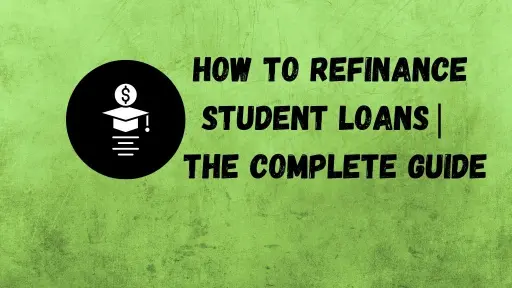Refinance Student Loans | Maximize Savings and Reduce Debt Fast | Expert Tips and Step-by-Step Guide for Beginner
Refinance Student Loans: Student loan debt in the U.S. now tops $1.77 trillion. With interest rates easing from their 2023–2024 highs, 2025 is a great year to refinance. Borrowers with older loans at 6–8% (or higher) can save hundreds each month or pay off their debt years earlier.
Refinancing isn’t for everyone. If you have federal loans and value income-driven repayment or forgiveness programs, refinancing may not be the best choice. This guide explains everything: what refinancing is, who should do it, savings examples, what lenders look for, and a simple step-by-step process.
What is Student Loan Refinancing?
Refinancing means taking out a new private loan to pay off one or more existing loans. The new loan has a new interest rate and repayment term, ideally lower than your current rate.
Difference Between Refinancing and Consolidation
Refinancing: Combines multiple loans into a new loan with a new interest rate. Can be federal or private loans. Terms and rates are based on your creditworthiness.
Consolidation: Specifically for federal loans. Combines multiple federal loans into one new federal loan with a weighted-average interest rate. Federal benefits, like income-driven repayment plans, remain intact.
Refinancing vs Consolidation
| Feature | Refinancing | Federal Consolidation |
|---|---|---|
| Lender | Private | U.S. Dept of Education |
| Interest rate | Usually lower, based on credit | Weighted average of old rates |
| Loan type | Private | Federal |
| Forgiveness eligibility | Lost | Preserved |
| Income-driven repayment | Gone | Still available |
| Best for | Strong credit, stable income | Keeping federal benefits |
How refinancing works:
- Apply with a private lender
- Lender reviews your credit, income, and employment
- Lender pays off your old loans
- You make one payment to the new lender
Federal vs Private Student Loans | Should You Refinance?
If You Have Federal Loans
Pros of refinancing federal loans:
- Rates as low as 4.96%–6.49% fixed (vs 8%+ for older loans)
- One monthly payment instead of multiple servicers
- Can save tens of thousands in interest
Risks:
- Lose access to income-driven repayment plans (SAVE, PAYE, IBR)
- Lose Public Service Loan Forgiveness (PSLF) progress
- No forbearance or deferment options
- No $0 payments if income drops
Tip: Only refinance federal loans if you don’t plan to use forgiveness programs and have stable income.
If You Have Private Loans Only
Refinancing is usually a smart move: lower interest rates, simpler payments, and better terms without losing federal protections.
Pros and Cons of Refinancing Student Loans
| Pros | Cons |
|---|---|
| Lower interest → saves money | Lose federal protections & forgiveness |
| One monthly payment | May extend repayment term → pay more interest |
| Fixed or variable options | Hard to qualify with low credit/income |
| Co-signer release possible | Variable rates can rise later |
| No origination fees from top lenders | Can’t refinance back to federal loans |
How Much Can You Save? Real-Life Examples
| Borrower | Original Loans | Original Rate | New Rate | Old Payment | New Payment | Total Interest Saved |
|---|---|---|---|---|---|---|
| Medical resident | $280k federal Grad PLUS + Direct | 7.9–8.5% | 6.24% fixed | $2,950 | $2,150 | $94,000+ |
| Software engineer | $85k private (5 loans) | 9.2% avg | 4.99% fixed | $1,020 | $720 | $36,500 |
| Teacher pursuing PSLF | $60k federal | 5.5% | 5.12% fixed | $650 | $620 | $3,800 (not worth losing PSLF) |
Rates from Credible, LendKey, SoFi, Earnest, Splash Financial (Nov 2025).
What Lenders Look for When You Apply
Top lenders consider:
- Credit score: 680+ (720+ for best rates)
- Debt-to-income ratio: ideally under 36%
- Income: $40k–$60k minimum
- Employment: stable, full-time
- U.S. citizen or permanent resident (some DACA accepted)
Tips to improve approval:
- Add a creditworthy co-signer
- Pay down credit card balances
- Wait for a raise or promotion
- Choose a shorter loan term
H2: Step-by-Step Guide to Refinancing Your Student Loans
Step-by-Step Guide to Refinancing Student Loans
- Check your current loans & rates: Use StudentAid.gov and private servicers.
- Shop multiple lenders: Compare 10+ lenders on Credible, LendKey, NerdWallet.
- Pre-qualify: Soft credit check → see real rates without affecting score.
- Gather documents: Pay stubs, W-2s, driver’s license, loan statements.
- Choose fixed vs variable & term:
- Fixed: predictable payments
- Variable: starts lower but may rise
- Submit final application: Hard credit pull occurs.
- Sign loan docs & wait for payoff: Old loans are paid off (10–30 days).
- Set up autopay: Often gives 0.25% rate discount.
Things to Consider Before Refinancing
- Federal benefits are gone forever (PSLF, IDR, forbearance).
- Shorter term → higher monthly payment but less interest.
- Longer term → lower payment but more total interest.
- 2025 is a great year to refinance with rates lowest since 2021.
Budgeting Tips While Paying Off Refinanced Loan
- Keep old payment amount: Extra goes to principal → pay off years early.
- Build emergency fund: 3–6 months of living expenses.
- Use windfalls: Tax refunds, bonuses, side hustle income → pay principal.
- Set up biweekly payments: Turns 12 payments/year into 13 → save interest.
FAQs
1. Is it a good idea to refinance student loans?
Refinancing is a good idea if you can get a lower interest rate or better terms.
But do NOT refinance federal loans if you rely on forgiveness programs (PSLF), Income-Driven Repayment (IDR), or may need hardship protections. Refinancing turns federal loans into private loans permanently.
2. What is a refinance student loan?
A refinance student loan is a new private loan that replaces one or more existing student loans.
Your new lender pays off the old loans, and you start making payments on the new loan—often with a lower rate.
3. Does refinancing hurt your credit score?
Only a small temporary drop (about 3–10 points) from the hard inquiry.
Your score often recovers in 3–6 months, and on-time payments can improve it long-term.
4. What credit score do I need to refinance student loans?
Most lenders require 650+.
Best rates in 2025 usually go to borrowers with 720–740+.
Co-signers can help if your score is lower.
5. What are the risks of refinancing student loans?
Main risks:
- You lose federal protections (PSLF, IDR, forbearance).
- Variable rates may rise later.
- Extending your term too long can make you pay more interest overall.
- You may not qualify again if your credit drops in the future.
6. What is the “2% rule” for refinancing?
This is outdated.
In 2025, experts recommend refinancing if you can reduce your rate by 0.5%–1%, especially on large balances.
Even a small drop can save thousands.
7. Is refinancing expensive?
Usually no.
Most major lenders charge no application fees, no origination fees, and no prepayment penalties.
(Only a few small credit unions still charge 1%.)
8. When should you NOT refinance student loans?
Avoid refinancing if:
- You’re pursuing PSLF
- You use IDR plans
- You expect income or financial hardship
- Your credit is too low to get a reasonable rate
- You want federal forbearance or forgiveness options
9. Is it hard to get approved for refinancing?
Approval depends on:
- Your credit score
- Stable income (usually $40k–$60k minimum)
- Debt-to-income ratio (DTI under 45–50%)
- Good payment history
If your credit is weak, adding a co-signer greatly improves approval chances.
10. How much is a $30,000 student loan monthly?
For a standard 10-year term:
- 5.00% interest → ~$318/month
- 7.00% interest → ~$349/month
Autopay discounts (0.25%) can lower payments slightly.







